Symeon the Studite, also Symeon the Pious or Symeon Eulabes, and sometimes Symeon the Elder, was an influential lay monk of the Monastery of Stoudios in Constantinople during the 10th century. He was the spiritual father, or teacher, of Symeon the New Theologian. [1] [2]
Little is known about Symeon's life. He was born around 918 AD and became a monk at the Monastery of Stoudios in 942—it is from his identification with the monastery that he is called "the Studite". He died in 986 or 987. Forty chapters in the book Patmiacus 427, all pertaining to the spiritual life, are credited to him as "Symeon the Devout" (Eulabes in Greek). His own writings show him as taking a practical approach to the spiritual life, while other writings from that time described him as a Holy Fool. [1] Symeon the New Theologian revered him as a saint, which drew the rebuke of church officials who felt the younger Symeon was honoring someone who they considered to be less than saintly. [3]

Hesychasm is a mystical tradition of contemplative prayer in the Eastern Orthodox Church. Based on Jesus's injunction in the Gospel of Matthew 6:6 that "whenever you pray, go into your room and shut the door and pray to your Father who is in secret; and your Father who sees in secret will reward you", hesychasm is the process of retiring inward by ceasing to register the senses, in order to achieve an experiential knowledge of God.

Theodore the Studite, also known as Theodorus Studita and Saint Theodore of Stoudios/Studium, was a Byzantine Greek monk and abbot of the Stoudios Monastery in Constantinople. He played a major role in the revivals both of Byzantine monasticism and of classical literary genres in Byzantium. He is known as a zealous opponent of iconoclasm, one of several conflicts that set him at odds with both emperor and patriarch. Throughout his life he maintained letter correspondences with many important political and cultural figures of the Byzantine empire; this included many women, such as the composer and nun Kassia, who was much influenced by his teachings.

Maximus the Confessor, also known as Maximus the Theologian and Maximus of Constantinople, was a Christian monk, theologian, and scholar.

The Hilandar Monastery is one of the twenty Eastern Orthodox monasteries in Mount Athos in Greece and the only Serbian monastery there. It was founded in 1198 by Stefan Nemanja and his son Saint Sava. St. Symeon was the former Grand Prince of Serbia (1166-1196) who upon relinquishing his throne took monastic vows and became an ordinary monk. He joined his son Saint Sava who was already in Mount Athos and who later became the first Archbishop of Serbia. Upon its foundation, the monastery became a focal point of the Serbian religious and cultural life, as well as "the first Serbian university". It is ranked fourth in the Athonite hierarchy of 20 sovereign monasteries. The Mother of God through her Icon of the Three Hands (Trojeručica), is considered the monastery's abbess.

The Philokalia is "a collection of texts written between the 4th and 15th centuries by spiritual masters" of the Eastern Orthodox Church mystical hesychast tradition. They were originally written for the guidance and instruction of monks in "the practice of the contemplative life". The collection was compiled in the 18th century by Nicodemus the Hagiorite and Macarius of Corinth based on the codices 472, 605, 476, 628 and 629 from the library of the monastery of Vatopedi, Mount Athos.

Kassia, Cassia or Kassiani was a Byzantine-Greek composer, hymnographer and poet. She holds a unique place in Byzantine music as the only known woman whose music appears in the Byzantine liturgy. Approximately fifty of her hymns are extant, most of which are stichera, though at least 26 have uncertain attribution. The authenticity issues are due to many hymns being anonymous, and others ascribed to different authors in different manuscripts. She was an abbess of a convent in the west of Constantinople.

John Cassian, also known as John the Ascetic and John Cassian the Roman, was a Christian monk and theologian celebrated in both the Western and Eastern churches for his mystical writings. Cassian is noted for his role in bringing the ideas and practices of early Christian monasticism to the medieval West.

Basilian monks are Catholic monks who follow the rule of Basil the Great, bishop of Caesarea (330–379). The term Basilian is typically used only in the Catholic Church to distinguish Greek Catholic monks from other forms of monastic life in the Catholic Church. In the Eastern Orthodox Church, as all monks follow the Rule of Saint Basil, they do not distinguish themselves as "Basilian".

Saint Paisius Velichkovsky or Wieliczkowski was an Eastern Orthodox monk and theologian who helped spread staretsdom or the concept of the spiritual elder to the Slavic world. He is a pivotal figure in Orthodox Church history.
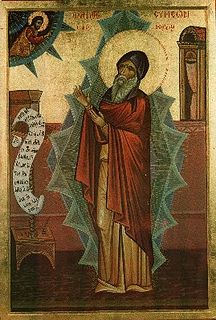
Symeon the New Theologian was an Eastern Orthodox Christian monk and poet who was the last of three saints canonized by the Eastern Orthodox Church and given the title of "Theologian". "Theologian" was not applied to Symeon in the modern academic sense of theological study; the title was designed only to recognize someone who spoke from personal experience of the vision of God. One of his principal teachings was that humans could and should experience theoria.

The Monastery of Stoudios, more fully Monastery of Saint John the Forerunner "at Stoudios", often shortened to Stoudios, Studion or Stoudion, was a Greek Orthodox monastery in Constantinople, the capital of the Byzantine Empire. The residents of the monastery were referred to as Stoudites. Although the monastery has been derelict for half a millennium, the laws and customs of the Stoudion were taken as models by the monks of Mount Athos and of many other monasteries of the Orthodox world; even today they have influence.
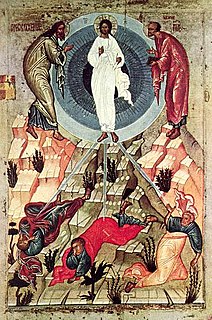
Mystical theology is the branch of theology that explains mystical practices and states, as induced by contemplative practices such as contemplative prayer.

A typikon is a liturgical book which contains instructions about the order of the Byzantine Rite office and variable hymns of the Divine Liturgy.

Eastern Christian Monasticism is the life followed by monks and nuns of the Eastern Orthodox Church, Oriental Orthodoxy, the Church of the East and Eastern Catholicism. Eastern monasticism is founded on the Rule of St Basil and is sometimes thus referred to as Basilian.
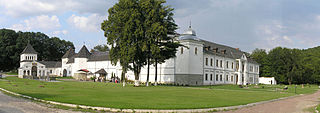
The Ukrainian Studites are a monastic order of the Ukrainian Greek Catholic Church.

Saint Joseph the Hymnographer was a Greek monk of the ninth century. He is one of the greatest liturgical poets and hymnographers of the Eastern Orthodox Church. He is also known for his confession of the Orthodox Faith in opposition to Iconoclasm.
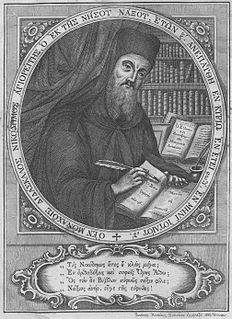
Nicodemus the Hagiorite or Nicodemus of the Holy Mountain is a saint of the Eastern Orthodox Church. He was an ascetic monk, mystic, theologian, and philosopher. His life's work was a revival of traditional Christian practices and patristic literature.
Niketas Stethatos was a Byzantine mystic and theologian who is considered a saint by the Eastern Orthodox Church. He was a follower of Symeon the New Theologian and wrote the most complete biography of Symeon, Life of Symeon.
Sabas of Stoudios was an abbot of the Monastery of Stoudios who played a leading role at the Second Council of Nicaea.
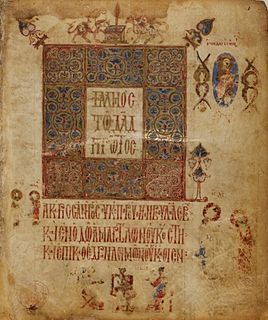
The Theodore Psalter is an illustrated manuscript and compilation of the Psalms and the canticles, or Odes from the Old Testament. "This Psalter has been held in the British Library since 1853 as Additional 19.352," wrote Princeton Art History professor Charles Barber in his first essay that is a companion to the Theodore Psalter E-Facsimile. Barber called the Psalter, "One of the richest illuminated manuscripts to survive from Byzantium."















